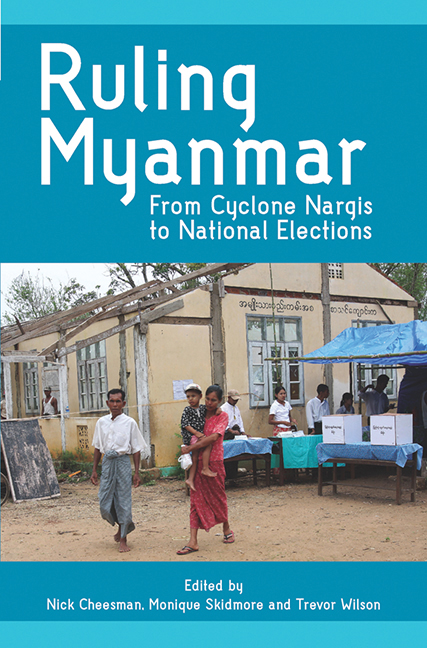Book contents
- Frontmatter
- Contents
- List of Tables
- List of Figures
- Background on ANU 2009 Myanmar/Burma Update Conference
- Acknowledgements
- Contributors and Editors
- Note on Terminology and Geographical Names
- Map of Myanmar
- Part I Overview
- Part II Political Legitimacy, Governance and Justice
- Part III Economic Development, the Rural Economy and Labour Rights
- 7 Myanmar's Response to the 2008 Global Financial Crisis
- 8 Recapitalizing Burma's Rural Credit System
- 9 Farmers, Land and Military Rule in Burma
- 10 The Movement of Rural Labour: A Case Study Based on Rakhine State
- Part IV The Role of International Cooperation and Governance
- List of Abbreviations
- Index
9 - Farmers, Land and Military Rule in Burma
from Part III - Economic Development, the Rural Economy and Labour Rights
Published online by Cambridge University Press: 21 October 2015
- Frontmatter
- Contents
- List of Tables
- List of Figures
- Background on ANU 2009 Myanmar/Burma Update Conference
- Acknowledgements
- Contributors and Editors
- Note on Terminology and Geographical Names
- Map of Myanmar
- Part I Overview
- Part II Political Legitimacy, Governance and Justice
- Part III Economic Development, the Rural Economy and Labour Rights
- 7 Myanmar's Response to the 2008 Global Financial Crisis
- 8 Recapitalizing Burma's Rural Credit System
- 9 Farmers, Land and Military Rule in Burma
- 10 The Movement of Rural Labour: A Case Study Based on Rakhine State
- Part IV The Role of International Cooperation and Governance
- List of Abbreviations
- Index
Summary
In August 2008, villagers were allegedly shot dead by soldiers while they worked in their paddy fields west of Papun Township. Incidents of forced labour are also reported, including in the construction and maintenance of eight roads and the portering of supplies to military posts. In Kayah State, the confiscation of land and work without remuneration in the agriculture sector was reported. In Thanbyuzayat Township, land was confiscated for the construction of rubber and castor-oil plantations and farmers were arbitrarily taxed. (UNGA 2009, pp. 57, 59, 60)
INTRODUCTION
Seventy-five per cent of Burma's 54 million people live in rural areas. The country's economic structure depends on agriculture and farm-related activities that provide livelihoods to more than 65 per cent of the population. While most rural households are engaged in farming as operators or labourers, and agriculture accounts for over half of the country's gross domestic product, only about one-fifth of rural households currently run viable farms of at least five acres (Dapice 2009, p. 11). Despite Burma's highly fertile agricultural land, some 32 per cent of the population are deprived of adequate food, nutrition and essential non-food items, with poverty levels particularly higher in rural areas (UN Human Development Initiative 2009).
Farmers with no clear rights of land ownership face severe survival pressures in Burma. An estimated one-half to two-thirds of rural households are landless farmers or farm labourers. Farmers’ survival is further threatened when their land is confiscated. The State Peace and Development Council (SPDC) has implemented large-scale, arbitrary land confiscations in order to relocate civilian populations deemed supportive of armed opposition groups; to establish military bases in disputed areas by constructing or supporting new army battalions; to create infrastructure development projects such as the proposed Salween River dams; to facilitate natural-resource extractions such as the offshore Arakan Shwe Gas project; and to privilege interest groups such as military and foreign investors with commercial opportunities, in mining, logging and agriculture. The United Nations General Assembly has reported the broad negative cultural, social, environmental, and economic consequences of these confiscations (2006, p. 14).
- Type
- Chapter
- Information
- Ruling MyanmarFrom Cyclone Nargis to National Elections, pp. 147 - 167Publisher: ISEAS–Yusof Ishak InstitutePrint publication year: 2010



